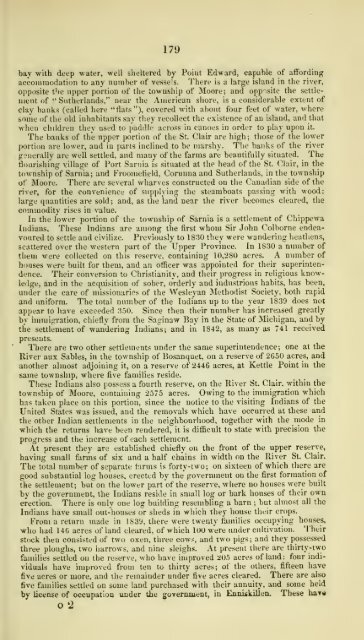Smith's Canadian gazetteer - ElectricCanadian.com
Smith's Canadian gazetteer - ElectricCanadian.com
Smith's Canadian gazetteer - ElectricCanadian.com
You also want an ePaper? Increase the reach of your titles
YUMPU automatically turns print PDFs into web optimized ePapers that Google loves.
179<br />
bay with deep water, well sheltered by Point Edward, capable of affording<br />
acconiinodation to any number of vessels. 'J'here is a large island in the river,<br />
opposite t'le upper portion of the townsliip of Moore; and opp-isite the settlement<br />
of " Sutherlands," near the American shore, is a considerable extent of<br />
clay banks (called here "flats"), covered with about four feet of water, where<br />
some of the old inhabitants say they recollect the existence of an island, and that<br />
wlieii cliildren they used to [)adilii' across in canoes in order to play upon it.<br />
The hanks of the upper portion of the St. Clair are hijjh; those of the lower<br />
portion are lower, and in parts inclined to be marshy. Tlic banks of the river<br />
generally are well settled, and many of the farms are beautifully situated. The<br />
flourishing village of Port Sarnia is situated at the head of the St. Clair, in the<br />
township of Sarnia; and Froomefleld, Corunna and Sutherlands, in the township<br />
of Moore. There are several wharves constructed on the <strong>Canadian</strong> side of the<br />
river, for the convenience of supj)l}ing the steamboats passing with wood:<br />
large quantities are sold; and, as the land near the river be<strong>com</strong>es cleared, the<br />
<strong>com</strong>modity rises in value.<br />
In the lower portion of the township of Sarnia is a settlement of Chippewa<br />
Indians. These Indians are among the first whom Sir John Colborne endeavoured<br />
to .settle and civilize. Previously to 18.30 they were wandering heathens,<br />
scattered over the western part of the Upper Province. In 18.30 a number of<br />
them were collected on this reserve, containing 10,280 acres. A number of<br />
houses were built for them, and an officer was appointed for their superintendence.<br />
Their conversion to Christianity, and their progress in religious knowledge,<br />
and in the acquisition of sober, orderly and industrious habits, has been,<br />
under the care of missionaries of the Wesleyan Methodist Society, both rapid<br />
and uniform. The total number of the Indians up to tiie year 1839 does not<br />
appear to have exceeded 3.50. Since then their number has increased greatly<br />
by immigration, chiefly from the Saginaw Bay in the State of Michigan, and by<br />
the settlement of wandering Indians; and in 1842, as many as 741 received<br />
presents.<br />
There are two other settlements under the same superintendence; one at the<br />
River aux Sables, in the township of Bosanquet, on a reserve of 2G50 acres, and<br />
another almost adjoining it, on a reserve of 2446 acres, at Kettle Point in the<br />
same township, where five families reside.<br />
These Indians also possess a fourth reserve, on the River St. Clair, within the<br />
township of Moore, containing 2,')75 acres. Owing to the immigration which<br />
has taken place on this portion, since the notice to the visiting Indians of the<br />
United States was issued, and the removals which have occurred at these and<br />
the other Indian settlements in the neighbourhood, together with the mode in<br />
which the returns have been rendered, it is difficult to state with precision the<br />
progress and the increase of each settlement.<br />
.At present they are established chiefly on the front of the upper reserve,<br />
having small farms of six and a half chains in width on the River St. Clair.<br />
The total number of separate farms is forty-two; on sixteen of which there are<br />
good substantial log houses, erected by the government on the first formation of<br />
the settlement; but on the lower part of the reserve, where no houses were built<br />
by the government, the Indians reside in small log or bark houses of their own<br />
erection. There is only one log building resembling a barn ; but almost all the<br />
Indians have small out-houses or sheds in which they house their crops.<br />
From a return made in 1839. there were twenty families occupying houses,<br />
who had 146 acres of land cleared, of which 100 were under cultivation. Their<br />
stock then consisted of two oxen, three cows, and two pigs; and they possessed<br />
three ploughs, two harrows, and nine sleighs. At present there are thirty-two<br />
families settled on the reserve, who have improved 20.') acres of land: four individuals<br />
have improved from ten to thirty acres; of the others, fifteen have<br />
five acres or more, and the remainder under five acres cleared. There are also<br />
five families settled on some land purchased with their annuity, and some held<br />
by license of occupation under the govermiient, in EnniskiUen. These h&f*<br />
o2

















